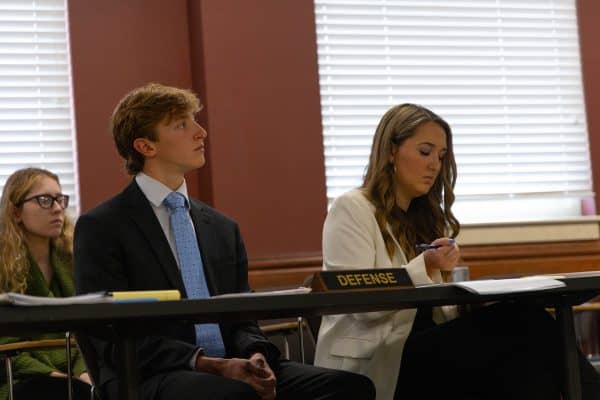Josh’s View | Why Phoebe Bridgers’ grand SNL finale inspired mixed reviews
The Grammy-winning singer has many tricks up her sleeve. But smashing a guitar on “Saturday Night Live” was not an audience favorite.
Smashing a guitar was always an item on the bucket list for American singer-songwriter Phoebe Bridgers.
Luckily, she would make her dreams a reality on the “Saturday Night Live” aired Saturday, Feb. 6, a day ahead of the Super Bowl. The episode, hosted by Dan Levy, star of “Schitt’s Creek” and “Happiest Season,” pillaged through skits on sports reporters, Super Bowl fans, a hyper-erotic parody of the real estate app Zillow and many other pandemic-themed antics.
After an enthusiastic introduction from Levy, the studio’s lights dimmed and the stage softened to somber lighting that mimicked the haunting yet simplistic artwork of Bridgers’ sophomore album, “Punisher.”
One fan account was quick to note that the stage backlighting resembled a mountain range similar to the one Bridgers stood in front of on her album cover.
https://twitter.com/pathos_golden/status/1358322418293612546
The look of the performance was actually packed with double the references to the record’s cover design: Bridgers also wore a dress bejewelled to resemble a human ribcage, an homage to the skeleton hoodie the singer often appears in.
Bridgers first performed “Kyoto,” a single from “Punisher” written about Bridgers’ faltering relationship with her father.
The band accompanying Bridgers in between the two tracks are night and day, though they remain all the same. Bridgers was accompanied with a cast of musicians similar to an orchestra or musical ensemble fit with a violinist and two performing with trumpets.
Then for her final performance, Bridger performed “I Know the End,” a song that heralds impending doom with a scream and a chant of “the end is here.”
The song is an amalgamation of multiple anecdotes ribbon-tied to describe a certain emotion Bridgers was feeling after a breakup with her drummer.
What started as a passion project on ending her sophomore album with a scream turned into a piece centered on the feeling of purgatory after the loss of a long-standing relationship and even being on tour.
“[It’s] just kind of being at peace with the end of the world,” she said in a Genius interview. “And I don’t mean in like an apathetic way.”
As the song headed into its climax Bridgers’ passion was showcased fully.
As the singer made several blows to the fake monitor, sparks ran rampant like a Fourth of July firework show. The guitar, however, remained perfectly intact.
“I’ve always wanted to do it,” she said in an on-air interview with CNN reporter, Christiane Amanpour. “And then when I mentioned it to the show, they were really excited.”
SNL producers were quick to give Bridgers the motion-detected monitor to mimic similar stage pyrotechnics and one guitar company even spotted her with the essential prototype for the endeavor.
Company Danelectro alluded to the stunt the day after with a tongue and cheek Twitter message.
Hope you have all had a smashing weekend…?
— Danelectro Official (@DanelectroUSA) February 7, 2021
But what Bridgers, producers and the guitar company relished, one critic saw as an excuse to be a bad musician.
David Crosby, a founding member of the all-American classic rock bands Crosby, Stills & Nash and The Byrds, took to Twitter, on Feb. 8, to share his feelings on the use of guitars during a performance.
“Guitars are for playing [and] making music, not stupidly bashing them on a fake monitor for childish stage drama,” he said.
Guitars are for playing ..making music …..not stupidly bashing them on a fake monitor for childish stage drama …..I really do NOT give a flying F if others have done it before
It’s still
STUPID— David Crosby (@thedavidcrosby) February 9, 2021
After the post, Crosby began responding to comments questioning Bridgers as an artist.
“I am told that wasn’t a very good night for her, and she’s really quite good,” he said. “I could not see it or hear it then. The skeleton costumes were kind of distracting as well.”
Fans of Bridgers were quick to call him and other male critics misogynistic.
Attacking a female rocker for coming off as "angry" is baldly misogynistic. It just is. Every one of us has saluted male rockers *for* being angry, but when a woman w/ a guitar has passion, how she "behaves" is ridiculed. But what about her performance/songwriting was "childish"?
— Adam Perry (@deathorglory80) February 9, 2021
One-hit wonder and “Teenage Dirtbag” singer Wheatus even stepped into the line of crossfire.
disagree with you, man…disappointing to see you become what you fought. hope you can see through.
— wheatus (@wheatus) February 10, 2021
Others along with Crosby were quick to call the planned aspect of her instrument-splitting antithetical to the genre.
It looked so lame. staged. Not real emotions hence not passion
And yes, a fine instrument should not be subject to abuse— Susan (@boyle_sboyle) February 9, 2021
Yeah. That was my criticism. Townsend did it as an act, too – but it was an act that flowed out of the frustration & anger of his music & performance. He was a good actor. She's not. Which made it seem tacked on and, yes, lame.
— Bennett Cohen (@bennettscohen) February 9, 2021
Ultimately, Bridgers got a kick out of the whirlwind of insults thrown both at her and Crosby.
“Can’t believe I am the first woman ever,” she said in a tweet referencing the multiple news articles dissecting responses to the incident.
https://twitter.com/phoebe_bridgers/status/1359567419468038151
The vast difference in opinion on Bridgers’ performance made one thing clear: there is a generational gap between appropriate album rock listeners with the now conventional indie rock listener.
Bridgers became big only in 2017, when her debut album “Stranger in the Alps,” appeared on two different Billboard album charts. It peaked No. 13 on the Heatseekers Albums list and No. 38 for Independent Albums in the United States.
Guitar-smashing was often emblematic for the vivacious energy exhibited by rockers of the 1960s and ‘70s, including acts like The Who, Deep Purple and The Clash.
Instrument destruction has become less common as time has progressed, and Twitter and journalists are always drawn to the uncommon and bizarre. But the question remains: Did Bridgers make headlines due to the lack of guitar-smashing in recent years or because she is in fact a woman smashing a guitar?
Rock for decades has been dominated by men, though cracks are beginning to form in the genre’s largely male facade. The Rock and Roll Hall of Fame announced their 2021 nominee list on Feb. 10 and nearly half of this year’s nominees were female singers or women-fronted bands. The list also included nominees who may receive their second induction, Carole King and Tina Turner. They will be the second and third female soloists who have ever done this besides Fleetwood Mac frontwoman Stevie Nicks.
But rock slowly recognizing its foundational female influence doesn’t change the fact that Bridgers has been subject to more scrutiny than any of her male counterparts who’ve had similarly destructive finales.
It’s not as if stratocaster-slamming suddenly died in the 20th century. Rockers in the 2000s and even 2010s smashed their guitars, often with very little response. This was also not the first instrument destroyed on the set of “Saturday Night Live.” Arcade Fire frontman Win Butler destroyed an acoustic guitar during the song “Intervention” in a 2007 episode. Crickets.
Similarly, Green Day members not only destroyed a guitar but a bass guitar and even a drum set all in 2012.
Bridgers simply hit a guitar – which normally costs under $100 – on a monitor in an event that was all planned.
Yet, when Jimi Hendrix poured lighter fluid over his guitar or Kurt Cobain obliterated his instrument, they were regarded as rock heroes, though perhaps much to Crosby’s disdain. But Bridgers – an artist only notorious for the last four years – has yet to make any impression on the not-so nimble listeners of classic rock.
Maybe it is because Bridgers planned the incident. Maybe that is not the spontaneity of rock music. Or maybe it speaks true to underlying prejudices we still face in American and Western society.
Though Twitter likes are not the sturdiest metric for fan support, Bridgers’s single tweet stands with more than 150,000, whereas Crosby has yet to break 5,000 on any of his tweets on the situation.
Fan of her performance or not, this will be a “Saturday Night Live” episode many will remember.
It is simply an age-old tale of out with the old and in with the new.
Joshua LeBerte is a sophomore studying news media. His column, “Josh’s View,” covers national pop culture items and runs regularly.











